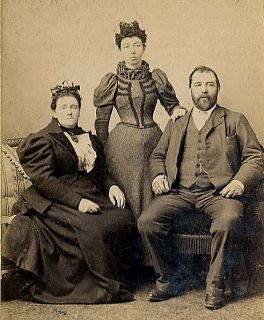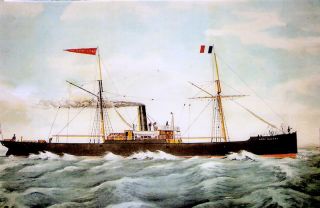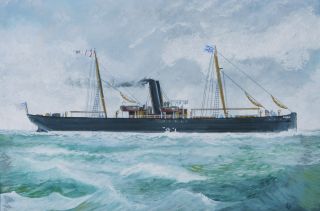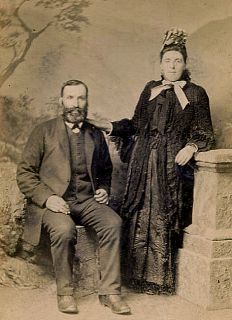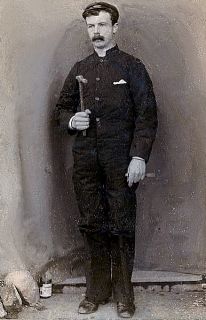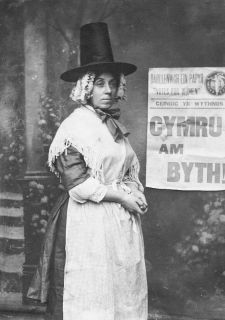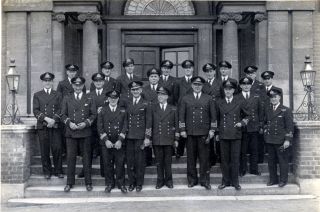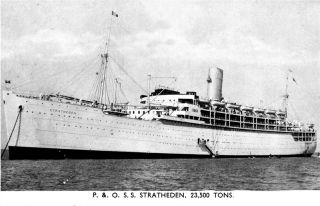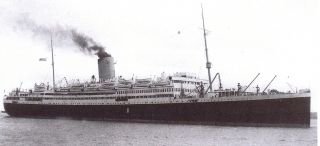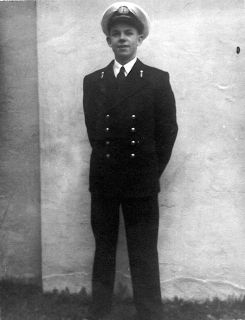THE RICHARDS MARINERS
Captain William Richards 1845-1912, gained his masters certificate in 1872 and commanded the sailing vessels Cecil Brindley in1873, Martha from 1874 to 1879 and the steamers Glenalvon 1879 to 1882, Eira 1882 to 1883 and the Lady Mostyn from 1883 to 1888. He had begun his career as ships boy at twelve years of age, and at sixteen, he was a seaman on the sixty-ton Aberystwyth registered schooner Maid of Merion. He then went on to serve on the Forest Princess, Punch, Forest Queen, Annie Brocklebank and the Mary Elizabeth; all sailing vessels. He was one of eight children, David b.1841, Margaret b.1834, William b.1845, John b.1848, Jane b.1850, Thomas b.1852. Evan b.1855 and Anne b.1858. All the boys became mariners. Of the three sisters, Margaret married Captain John Vaughan, Jane married Evan Jenkins and Anne remained a spinster. Captain William Richards' father John b.1821, was a mariner, but on some documents he was noted as a farm labourer who had been born in Llanafan and married Margaret b.1818, a Borth girl. At one time they lived at Rose Place, Morfa Borth.
CAPTAIN RICHARDS
S.S. LADY MOSTYN S.S. EIRA
There was a degree of notoriety attatched to the family as William's brother Thomas b.1852, who had served on the schooners Koh-I-Noor , Cecil Brindley and the steamer Electra, was hanged at Carmarthen for the murder of his sister-in-law Mary Davies nee Hughes at the cottage now known as Nerella. Her husband James Davies had often sailed with his brother-in-law Thomas on the S.S. Electra. There had been an ongoing feud between the two sisters Mary and Catherine Richards nee Hughes, over the cottage. The sisters had been left an equal share of the property; and whilst childless Mary and her husband enjoyed its use, Catherine and Thomas and their three children had to rent Sandon Villa, Upper Borth. There is a vast amount of reportage around the murder and subsequent trial which can be found in the National Library of Wales' newspapers on line. The perpetrator was shunned by the rest of his family except for his wife and children. Perhaps it was this event that persuaded Captain William Richards to build a third house called Maelgwyn at Pengarn, so he could distance himself somewhat from the scandal. Currently little is known about David b.1841, John b.1848 or Evan b.1855, only that the latter is recorded as being at sea during the 1881 census.
Anne, wife of Captain William Richards, had a sister who also married a mariner; Captain Griffiths. He had been born in Dolau of farming stock. He left home at the age of fourteen to work with the vicar of Pennal. The young man’s intelligence aligned with a keen interest in seafaring so impressed his employer that he sent him to study navigation with the polymath Cranogwen, which was the Bardic name of Sarah Jane Rees 1839-1916 who lived at Llangrannog. Sarah was a precocious child and at a young age persuaded her captain father to take her on his voyages as opposed to home duties and sewing. She became a competant mariner and skilled navigator under her father's tutelage, supplemented later by attending navigation school in London. This was only one facet of her prodigious talent. Young Griffiths gained his master mariner certificate in Dublin and went on to command the Mexican and the Roebuck of Wisbech. On one of his voyages, after a two year absence, it was presumed that the ship and the crew were lost. No sooner had the insurance been paid out, and other matters concluded, than the long overdue ship returned causing great consternation. Not least of all to his wife, and apparently after this event she persuaded Captain Griffiths to give up seafaring and to concentrate on agricultural matters at Dolclettwr Farm Treddol.
CAPTAIN GRIFFITHS AND WIFE
JOHN THOMAS RICHARDS MARY DAVIES (nee Richards)
Amongst these aforementioned letters are some from Richard Williams, a schoolteacher from Borth, who at one time courted Mary Elizabeth. In them he complains that despite blowing a whistle at intervals to signal that he was near her home at Pengarn, she did not come to meet him. This romance did not progress, as she later married a Davies from nearby Aberceiro. Mary Elizabeth and her husband moved to London as her father had bought them a dairy business. The fiesty independant minded Mary became the first female sanitary inspector in Britain and an active member of the suffragette movement. There is more material about Captain William Richards in the Borth Stories segment of this website.
The captain’s surviving son David had two sons, one of whom went to sea. Edward “Ted” Albert Richards 1904-1981 was in the R.N.V.R. during World War 2. He attended Towyn Grammar School where he excelled academically. Despite this he was not happy there, as he frequently recalled walking out onto Towyn beach to look south to Borth, often ending up crying. Ted went on to take a degree in chemistry at the U.C.W. Aberystwyth, but decided that he would prefer to be in the arts than the sciences. By 1928, he was in London in a book retailing partnership. Times were quite lean in the 1930’s, and he took on bit part acting jobs and began writing plays. Many of these were abstractions of Borth’s historical associations with the sea, such as, Master Mariner, Who’ll Buy My Fresh Herrings and Herring Harvest. Overall, he wrote twenty-four plays and a few short stories, some of which were later re-drafted and presented on radio. One of his stories Worthy is the Lamb, is included in the Oxford University Press Anthology of Welsh Short Stories.
A.E. RICHARDS (far left)
At the end of 1941, with the war reaching a crucial state, he decided to do his bit and joined up. It was natural that he would join the navy, but his age dictated that it would be in the R.N.V.R. He was soon promoted and found himself involved with training exercises on minesweepers. Ted often remarked about the comical mix of the crew on these vessels. Most of the skippers were trawler men in peacetime, who knew the coastal waters in and around the English Channel like the back of their hand. These rough and ready men, now uncomfortably uniformed, were trying to organize hapless officer recruits from public schools and the professions, who had no sea going experience. Other than his sea going duties, Ted, because of his background, became involved in liaison duties, looking after the welfare of new recruits and organizing sporting events and theatrical entertainments.
Ted often recalled that on one busy recruiting day when he hardly glanced at the procession of new faces, as he called out “name and address etc”, a small voice replied “Ted bach fi sydd yma; rhwyn perthin i ti” (dear Ted, it’s me here, I am related to you). It was ships cook Llew Jenkins from Borth, who had found out where Ted was stationed, and had come to invite him to share some food he had smuggled ashore. Trite a story it may seem, but Ted often recalled it wistfully. Llew took him to his rented room high in the attic of a London house, and on a little gas ring cooked a sumptuous feast of bacon and eggs. This was something very rare at the height of rationing and as Ted stated “thank God the skylight was opened so the aroma would not attract attention”. At the end of the war, and for a few years afterwards, Ted was on repatriation vessels making several round trips to Australia, South Africa and America. It was on such a voyage on the Stratheden that he met up with Borth man William Williams of Penbont. After the war, he returned to Borth with his wife and children to run a dairy business.
Some descendants of this branch of the family had only tenuous links with the sea. Ted’s son Paul b.1944, ran inter-island vessels as part of his brief when District Officer in the Solomon Islands in 1970. He then returned to Britain and taught at H.M.S. Arethusa for a time. After emigrating to Australia in 1976 he pursued a teaching career, and is currently, in his retirement, a member of the Australian Volunteer Coast Guard. Ted’s brother John Thomas, “Jac”, named after his long lost ships engineer uncle, has a son John b.1946, who served for thirty-five years in the R.A.F; and a daughter Ann 1942-1995, was married to David Morgan of Bow Street who went to H.M.S. Conway, and was for a time an officer in the Merchant Navy.
Captain William Richards’ great-grandson Thomas Davies b.1937, descended from his suffragette daughter Mary Elizabeth Davies, decided to go to sea when he was about five years old. The catalyst for this decision was the discovery of a watercolour of the S.S. Lady Mostyn in the attic of Maelgwyn House; his great grandfathers last command. Tom joined his first ship the tanker British Diligence in Swansea. He served on a dozen ships and travelled as he says “most of the seas; some benign, some ferocious“. Tankers laden were the least affected by bad weather, but in ballast were much higher out of the water making it difficult. On one trip to Australia, fully loaded, Tom’s ship was caught in a typhoon, but all he can remember was being excited, but quite a few on board donned lifejackets. Tom served on five other tankers; British Councillor, British Diplomat, British Ranger, British Harmony and British Skill.
Tom then joined the Royal Mail Line, as he was attracted to the idea of voyaging to South America. At this point his father presented him with his grandfather’s sextant, it was an old Vernier type and very different from new sextants at the time. Tom took it with him and used it despite the funny looks the first time he took a noon sight…..it was a just as accurate as anyone else’s. Tom’s first ship with Royal Mail was the Highland Monarch, a cargo passenger ship on the Brazil River Plate run carrying outward passengers in three classes. It had the mail contract for the South America run and delivered and collected mail from all the ports it stopped at; La Coruna, Vigo, Lisbon, Las Palmas (Canaries) Recife, Bahia, Rio De Janeiro, Santos, Montevideo and Buenos Aires. Tom was mail officer and hardly got ashore as the ship would arrive early in the morning and sail late in the afternoon.
Tom made four trips on the Highland Monarch and then joined the Parima, and later the Alcantara. Unfortunately it was on this ship that he contracted polio as it was approaching Brazil. He was hospitalised ashore at Rio De Janeiro for several months. When he got home, Tom had to convalesce at the Dreadnought Seamen’s Hospital in Greenwich for a couple of weeks, on half pay. For a time, post hospitalisation, he became a ship keeper. When a vessel arrived home and the officers were due leave, ship-keepers would “keep ship”. This entailed keeping the log, overseeing cargo and so forth. Most ship-keepers were retired officers. Tom soon declared himself fit and went back to sea, first on the Albany, then the Durango, Borth man John Lloyd's old ship. Tom did five trips on the Durango, and on the last trip met his wife to be, who was amongst the passengers. After getting married, Tom resigned and went to work with the Lotus Car Company. His recent illness, and being newly married, contributed to him leaving the sea. Tom has done many things including sailing the Atlantic and serving on the Winston Churchill as a watch Officer. He lived for over a decade at Ardwyn House, Borth. Tom and his wife Maruchy currently live in Denmark but annually visit Borth
ALCANTARA
THOMAS DAVIES
Captain William Richards had four children, and of the two sons the eldest John Thomas became a ships engineer. Unfortunately, he drowned at twentyfour years of age on the 17 September 1898 in the Far East whilst serving as third engineer on the S.S. Calisal. This occurred when the boat on which he was returning to his ship was driven hard against the vessel’s side, throwing him overboard. After this tragedy the other son, David, was forbidden to go to sea and became a carpenter. Several letters found recently in Maelgwyn Pengarn’s attic, by the current owner Richard Gethin, are from Eira crewmembers William Hunt and John Graham. They indicate that the captain’s two daughters, Peggy and Mary Elizabeth and their mother had gone with their father on the maiden voyage of the S.S Eira. According to his descendants,Captain Richards did not entirely trust this vessel in bad weather, and indeed his fears were borne out when she later vanished on a voyage between Whitehaven and Kronstadt in 1898.
